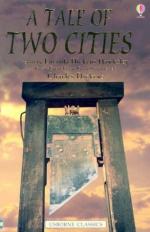|
This section contains 5,430 words (approx. 19 pages at 300 words per page) |

|
SOURCE: “The Carlylean Vision of A Tale of Two Cities,” in Charles Dickens's A Tale of Two Cities, edited by Harold Bloom, Chelsea House Publishers, 1987, pp. 23-35.
In the following essay, first published in 1976, Marcus compares aspects of Thomas Carlyle's French Revolution with A Tale of Two Cities.
A Tale of Two Cities is the most disparaged and least understood of Dickens's late novels. Overwhelmingly, the critics have judged the work a failure and dismissed it as intellectually superficial. According to this view, Dickens held only the most simpleminded view of history, and although the novel fictionalizes events whose memory haunted the Victorian era, it never places those events in the context of a coherent understanding of the processes of social change; the book is an amalgam of romantic melodrama based on Dickens's experience as an actor in Wilkie Collins's Frozen Deep and fragments taken from Carlyle's French...
|
This section contains 5,430 words (approx. 19 pages at 300 words per page) |

|


